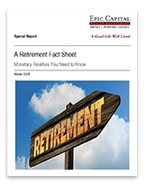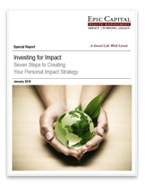Your Extended Care Strategy
Sep 18, 2019
Do you have an extra $33,000 to $100,000 to spare this year? How about next year, and the year after that? Your answer to these questions is probably “no.”
What could possibly cost so much? Eldercare. According to the AARP Public Policy Institute, a year of in-home care for a senior costs roughly $33,000. A year at an assisted living facility? About $45,000. A year in a nursing home? Approximately $100,000.
Medicare has limitations. Generally speaking, it will pay for no more than 35 hours per week of home health care and only up to 100 days of nursing home care, following a hospitalization. It may pay for up to six months of hospice care. If you or someone you love happens to develop Alzheimer’s disease or another form of dementia, Medicare will not pay for any degree of room and board for them at an assisted living facility.
Medicaid is another resource entirely. For seniors who are eligible, Medicaid can pick up assisted living facility or nursing home expenses, and even in-home eldercare, in some instances. Qualifying for Medicaid is the hard part. Normally, you only qualify for it when you have spent down your assets to the point where you can no longer pay for eldercare out of pocket or with insurance.
An extended care strategy may factor into a thoughtful retirement strategy. After all, your retirement may be lengthy, and you may need such care. The Social Security Administration projects that a quarter of today’s 65-year-olds will live past age 90, with a tenth making it to age 100.
Insurance companies have modified extended care policies over the years. Some have chosen to bundle extended care features into other policies, which can make the product more accessible. An insurance professional familiar with industry trends may be able to provide you more information about policies and policy choices.
Waiting for federal or state lawmakers to pass a new program to help with the costs of eldercare is not much of a strategy. It is up to you, the individual, to determine how to face this potential financial challenge.
If you lead a healthy and active life, you may need such care only at the very end. Assuming you do require it at some point, you may consider living in an area where you can join a continuing-care-at-home program (there are currently more than 30 of these, essentially operating as remote care programs of assisted living communities) or a “village network” that offers you some in-home help (not skilled nursing care, however).
Those rare and nice options aside, retirement saving also needs to be about saving for potential extended care expenses. If insurance addressing extended care is not easy to obtain, then a Health Savings Account (HSA) might be an option. These accounts have emerged as another solution to extended care needs. An HSA is not a form of insurance, but it does provide a tax-advantaged savings account to which you (and potentially, your employer) can make contributions. You can use these funds to pay for most medical expenses, including prescription drugs, dental care, and vision care. You can look into this choice right away, to take advantage of savings over time.
Once you reach age 65, you are required to stop making contributions to an HSA. Remember, if you withdraw money from your HSA for a nonmedical reason, that money becomes taxable income, and you face an additional 20% penalty. After age 65, you can take money out without the 20% penalty, but it still becomes taxable income.
An HSA works a bit like your workplace retirement account. Your employer can make contributions alongside you. However, the money that you contribute comes from your pretax income and can be invested for you over time, so it may grow as your contributions accumulate.
There are also some HSA rules and limitations to consider. You are limited to a $3,500 contribution for 2019, if you are single; $7,000, if you have a spouse or family. Those limits jump by a $1,000 “catch-up” limit for each person in the household over age 55. Your employer can contribute, but the ceiling is cumulative between your contributions and theirs. For example, say you are lucky enough to have your employer put a hypothetical $1,000 into your account in 2019; you may only contribute as much as the rest of your limit, minus that $1,000. If you go over that limit, you will incur a 6% tax penalty, so it is smart to watch how much you contribute.3
Alternately, you could do without an HSA and simply earmark a portion of your retirement savings for possible extended care costs.
One thing is for certain: any retiree or retirement saver needs to keep the possibility of extended care expenses in mind. Today is not too soon to explore the financial options to try and meet this challenge.
Tags: Health Care Savings
More Insights
Few terms in personal finance are as important, or used as frequently, as “risk.” Nevertheless, few terms are as imprecisely defined. Generally, when financial advisors or the media talk about investment risk, their focus is on the historical price volatility of the asset or investment under discussion.
As Americans get their grills and beach chairs ready for the July 4th holiday, the stock market and the weather across much of the country have both been on heaters. Stocks and bonds continue to effectively navigate a complex policy landscape shaped by evolving trade dynamics, geopolitical tensions, and fiscal stimulus. The market’s resilience in … Continue reading “Market Update – America Gets Record High Stock Prices for Its Birthday”
Birthdays may seem less important as you grow older. They may not offer the impact of watershed moments such as getting a driver’s license at 16 and voting at 18. But beginning at age 50, there are several key birthdays that can affect your tax situation, health-care eligibility, and retirement benefits.
During times like these when geopolitical headlines can be unsettling for investors, we at LPL Research like to remind ourselves of one of our key investing principles. Markets have always faced challenges —ranging from geopolitical conflicts and economic downturns to natural disasters, political upheaval and health crises. These events often trigger short-term volatility and shake … Continue reading “Why Long Term Investing Beats Selling in Volatile Times”
Are you concerned about the inheritance taxes your heirs may have to pay? Then you may want to consider creating charitable lead trusts.
Services
Epic Capital provides the following comprehensive financial planning and investment management services: Learn More >


 Top of Page
Top of Page











